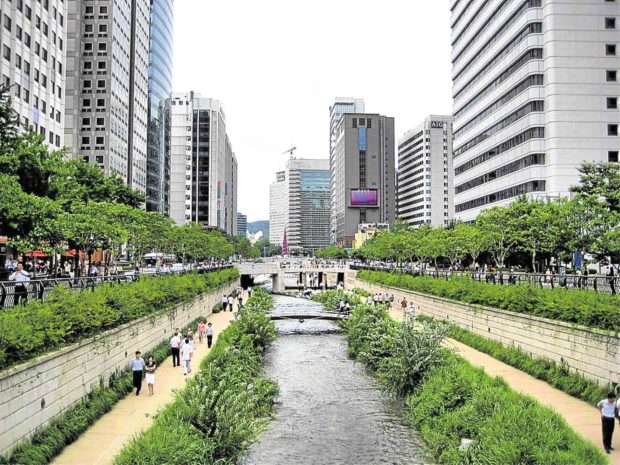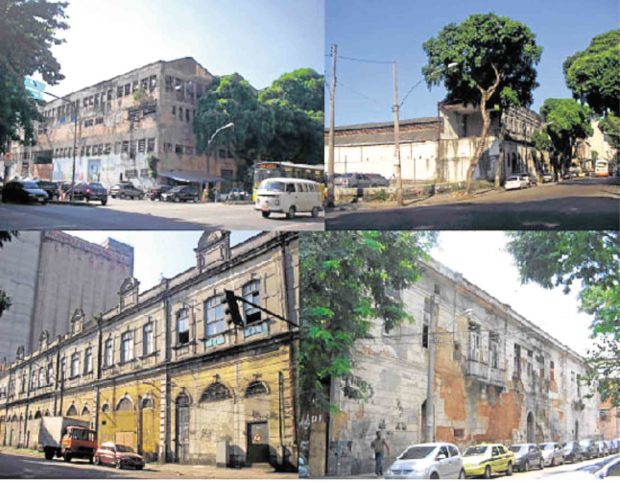Tales of urban regeneration
Amid the difficulties and struggles that plague our world today, there are a few occasions that would, once in a while, put our faith back in humanity.
Positive events that happen to individuals make us smile. Those that transform cities and nations, however, change lives for the better.
Let us take a look at cities and districts that unexpectedly became their country’s gems. As successful models of urban regeneration, we might learn a thing or two to further improve our own Philippine cities.
Breathing life into a stream
Who would have thought that reviving an old, buried waterway was possible in the city? Certainly not for many South Koreans, who first doubted the plans of then Seoul Mayor Lee Myung-bak in 2003. Back then, he proposed to remove the existing highway that ran above Cheonggyecheon Creek and restore the old stream.
Truth be told, the existing highway was built in the 1970s to intentionally cover up the waterway. Due to the increase in the city’s population, the natural creek became a canal filled with trash, sand and waste.
During Lee’s term, however, Seoul was experiencing another challenge that came with urbanization: traffic. Many South Koreans were worried that with the demolition of Cheonggyecheon flyover, traffic would worsen.

The Cheonggyecheon Creek is now a popular tourist spot that serves as a green corridor in the city of Seoul.
Determined to push through with his plan, Lee addressed the traffic problem first. His administration invested in intelligent public transportation systems to help the masses move easily through buses and rails. The project resulted in an increased use of public transport and reduced air pollution.
By removing the city’s dependence on the highway, the government was free to demolish the road and excavate the stream. Nearly dry underneath its concrete tomb, fresh water was pumped in from the nearby Han River. The edges of the stream were developed into a park. Existing vendors underneath the highway was relocated to a nearby stadium.
The project gave back to the city a natural gem. Once a source of embarrassment, the Cheonggyecheon Creek is now a thriving tourist spot. The renewed river introduced new animal species in Seoul, reduced pollution particles in the air and urban heat, and improved vehicular traffic. The government not only brought back nature into the concrete jungle, it also redesigned the city for the people’s enjoyment.
Reclaiming the port
Ports have always been the hotbeds of economic activity. Yet lately, with the development of other transportation routes, many are falling into neglect. Such is the case of Porto Maravilha, one of Rio de Janeiro’s oldest ports. A significant transport route that plays a hand in Brazil’s economy, the Porto Maravilha was degraded due to the reduction of port-related activities.
Many parts of the city laid in abandon. Antiquated buildings, which played part in the city’s history, went into slow decay. Real estate was not occupied and the port was merely becoming a passageway to other areas of the city.
To bring back life into the old port, the local government formed the Porto Maravilha Urban Operation. With state funding, the redevelopment was ambitious in its massive scope of 5 million sqm in land area. The project was initiated in 2009 and planned to be carried out over a period of 15 years on a budget of R$8 billion (equivalent to about P109.04 billion).
The project is so big it seems impossible, but it has started to make positive changes in the port area. Old buildings that originally served as passenger terminals were repurposed as event spaces. The demolition of Elevado da Perimetral, a flyover that spanned 4,900 meters in length, allowed the development of a new cycling pathway. The district was redesigned with humans in mind, with improved public transportation, cycling facilities and pedestrian provisions.
The project is still underway, yet the ripple effect among investors and changes are already being felt. The government aims to bring in more people and fix more parts of the city by revitalizing one area at a time. It is a promising venture into massive urban regeneration, and something that we look forward seeing in completion in a few more years.
Repurposing a district
Just because something is broken doesn’t mean it’s useless. This can be seen in the case of another port district in the South Americas. Puerto Madero, located in Buenos Aires, Argentina, could not accommodate large cargo ships, since its creation in the 19th century, due to its shallow river end.
As products and passengers had to be brought to the shore via barges, the government pushed for the creation of Puerto Nuevo in the early 20th century. The new port rendered the old one unnecessary. By the 20th century, Puerto Madero was on the road to decay.
The area left multiple parcels of land unused. The government, recognizing the wastage, developed several proposals over a period of 60 years either to demolish the old port or revive it. Yet it was only in 1989 that the “Corporación Antiguo Puerto Madero” (Old Puerto Madero Corp.) was formed, which pushed for the urbanization of Puerto Madero.
Unlike many government projects, the corporation relied on funding from the private sector. Thus, the redevelopment of the Old Port became more appealing to investors.
The old warehouses in the city were replaced by hotels, offices, lofts and private universities. The opening of the Hilton Buenos Aires, a five-star hotel, paved the way for other luxurious developments to follow suit. The area encouraged the patronage of superstar architects such as Norman Foster, Philippe Starck and Alan Faena. From a faulty, decaying port, Puerto Madero became an urbanized district that attracted professionals seeking to live the good life.

This panoramic photo of Puerto Madero shows its transformation from an old port into a bustling business district.
Nowadays, the Old Port is virtually unrecognizable with its new lease in life. Docks remain visible at the edge of the city, yet the area is now filled with high-rise buildings and yachts. The district is highly sought after by offices and young professionals. Real estate prices are better than ever. Not bad for an old port that was once closed down because it couldn’t serve its original purpose.
Sources: Luis Argerich via Flickr; Francisco Anzola via Wikimedia; portomaravilha.com.br; development.asia; urban-regeneration.worldbank.org

